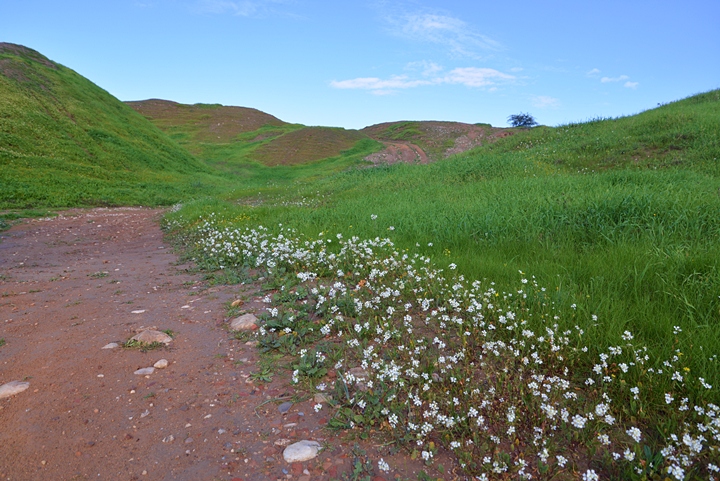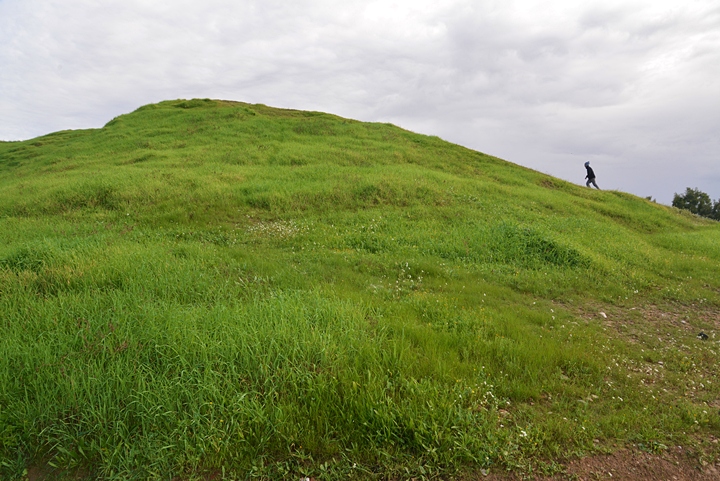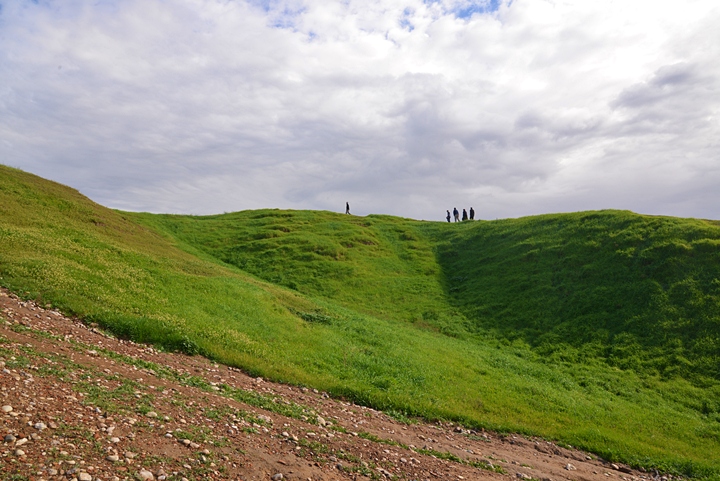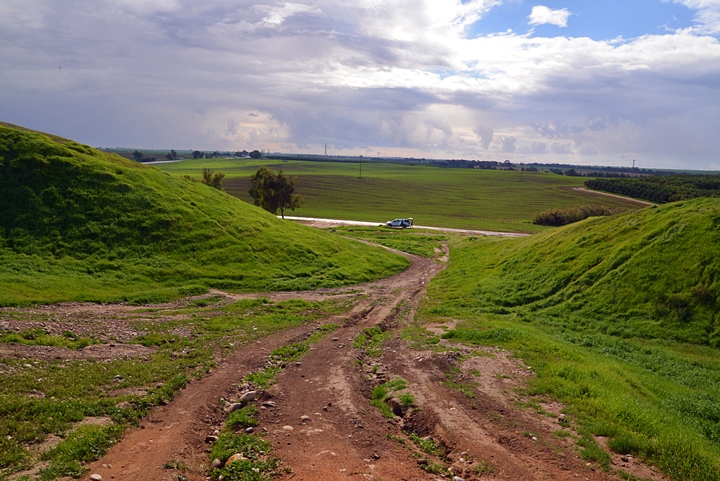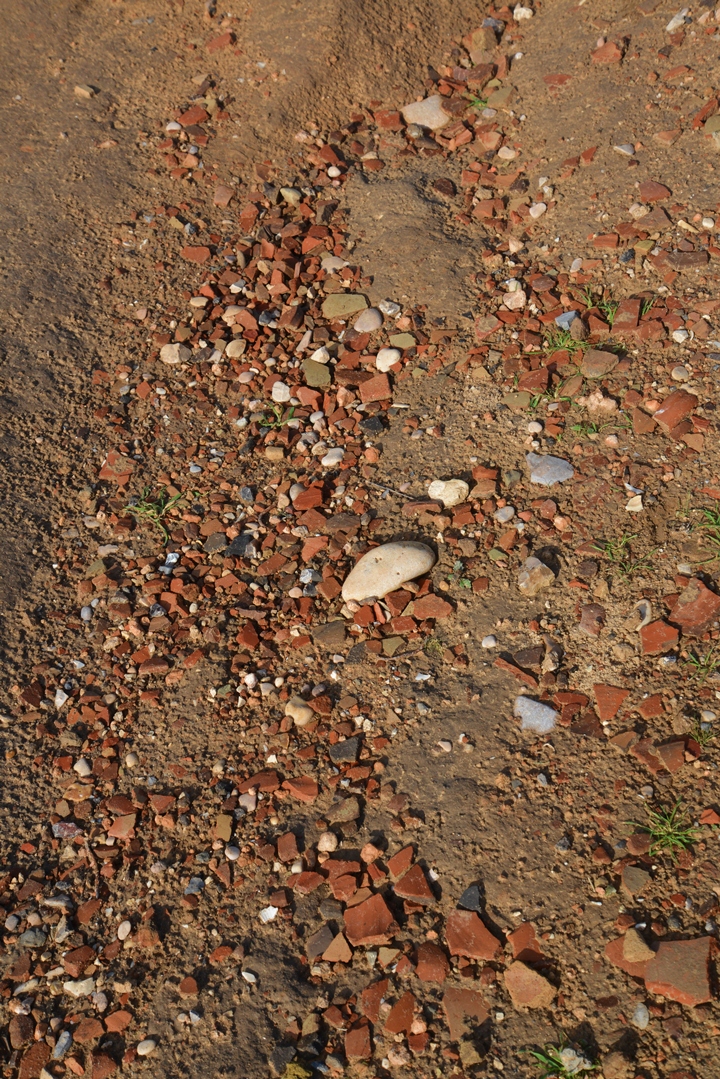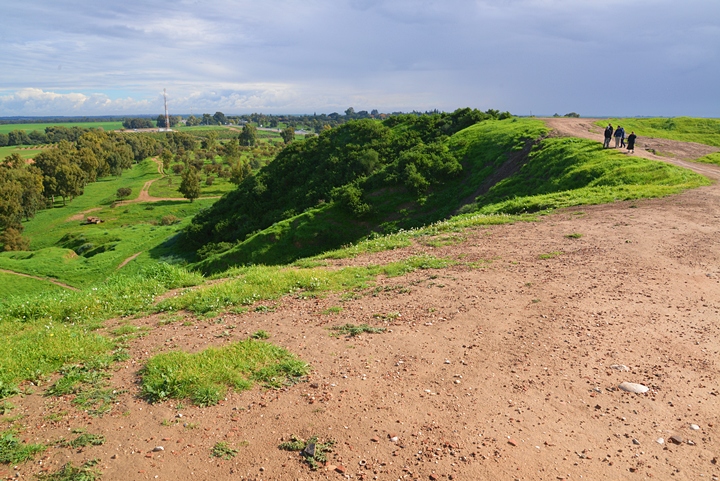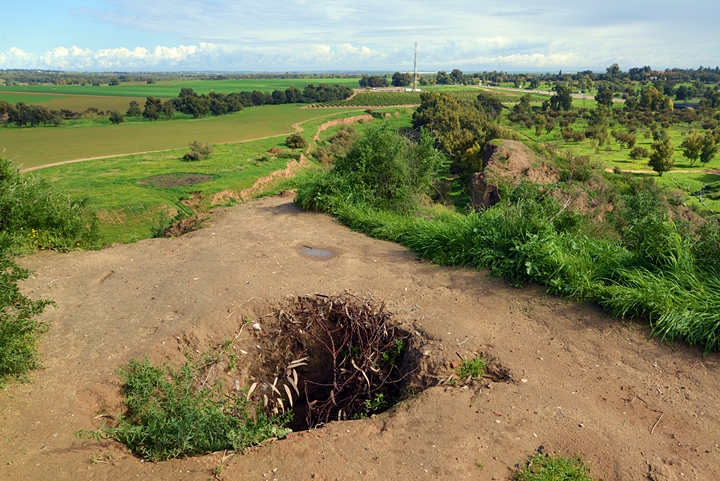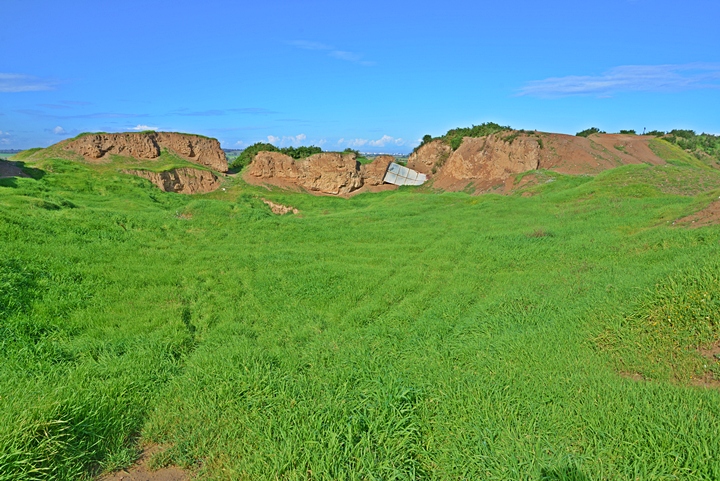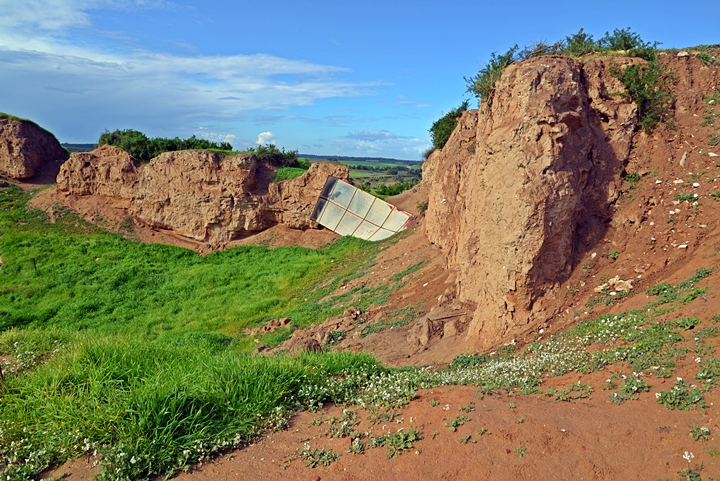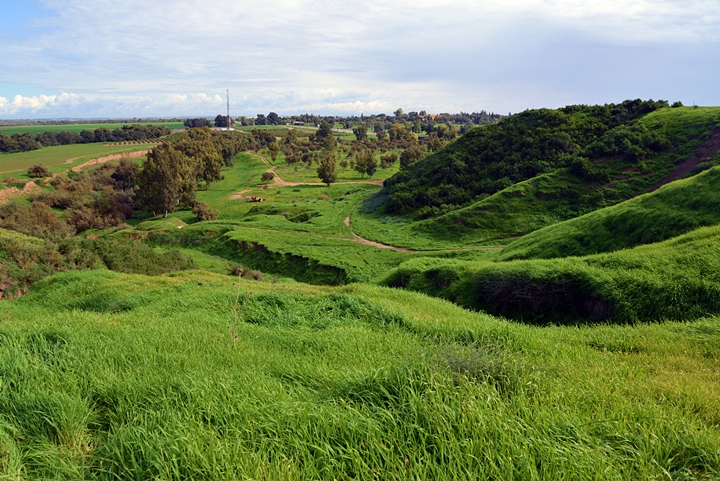Ruins of an ancient Canaanite and Philistine city on the Besor brook, identified as Yurza.
* Site of the Month Jan 2015 *
Home > Sites > Negev > West > Tel Gamma (Tell Jammeh)
Contents:
Background
Location
History
Photos
* General view
* Foothills
* Summit
* West side
* Besor views
* Aerial video
Etymology
Links
Overview:
In Tel Gamma, located on the bend of the Besor brook, are ruins of an ancient Canaanite city. It is believed to have been inhabited continuously from the Bronze Age to the Hellenistic period. It is identified as Yurza, a city referred in the conquest of pharaoh Thutmose III (reigned 1479-1425 BC). The city was an important trading post on the caravan route from the Mediterranean to Arabia, and one of the Philistine cities during the Iron Age.
Archaeological excavations at Tel Gamma have uncovered remains of a fortified city, including a massive stone wall and a gate complex. Other artifacts found at the site include pottery, weapons, jewelry, and coins, providing insights into the daily life and culture of the people who lived there.
In addition to its historical significance, Tel Gamma is also a popular destination for hikers and nature enthusiasts, as it offers stunning views of the surrounding landscape and a variety of flora and fauna.
Location and Map:
Tel Gamma (altitude 45m above sea level) is located to the south of the connection of two major brooks – the Besor (Wady Aza) and the Gerar (Wady es Sheriah). The Besor continues to flow to the Mediterranean sea, its outlet is located 10KM southwest of Gaza.
The site is located on the side of the road #232 from Kibbutz Re’im to Kibbutz Magen.
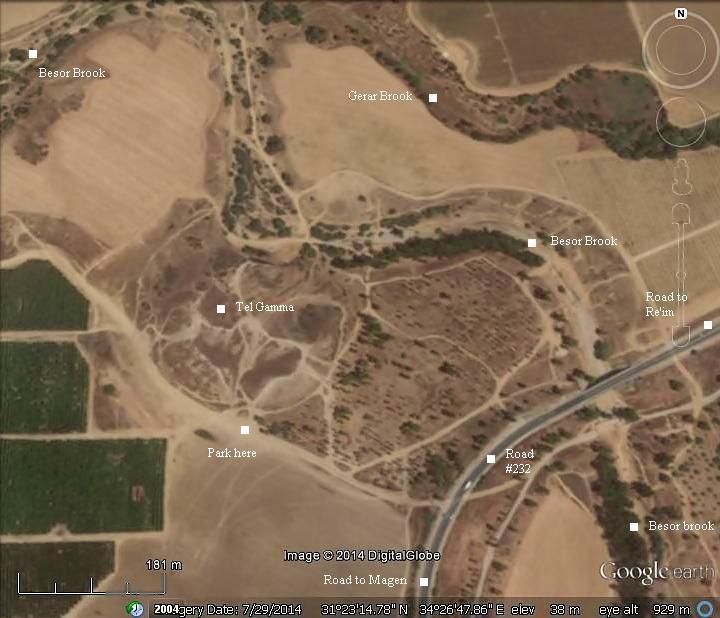
History:
-
Prehistoric periods
The excavations revealed settlements spanning from the Chalcolithic period (4500-3150 BC) to the Hellenistic period (3rd-1st Century BC). Flint stones and ceramics dated to the Chalcolithic period were found on the eastern side and in area III.
-
Canaanite period (Bronze age)
Egyptian records show that Egypt conquered Canaan during the 24th Century BC, following the intrusion of pharaoh Pepi I Myre (reigned 2332-2283 BC). The Egyptian reached the valley of Jezreel and controlled Canaan cities since then. The Egyptian reach extended to Phoenicia during the 20th and 19th Century. During this time the site was resestablished.
During the 15th Century the Canaanite Kings managed to group a coalition to free their cities from the Egyptian control. Pharaoh Thutmose III (reigned 1479-1425 BC), the greatest Egyptian conqueror, responded in an intrusion to Canaan. The climax of this conquest was the famous battle near Megiddo (1468 BC), which resulted in the Egyptian conquest of Canaan for the next 350 years.
Thutmose III inscribed in his palace at Karnak a list of 119 cities that were conquered during this conquest. One of the cities was Yurza. The inscription reads: “From the city of Yurza to the edges of the world”). This city, Yurza, is identified by scholars as the Canaanite city at Tel Gamma.
Walls and ceramics, dated to the Middle Bronze Age II (2000-1550), were found on the south side. From the Late Bronze period II (1300-1200 BC) the excavators unearthed a large public structure, perhaps a palace. This period was the peak of the city, with 8 phases of construction
Yurza is also mentioned in the Amarna Letters. This 14th century BC Egyptian archive of clay tablets mentions Yurza as a royal city .
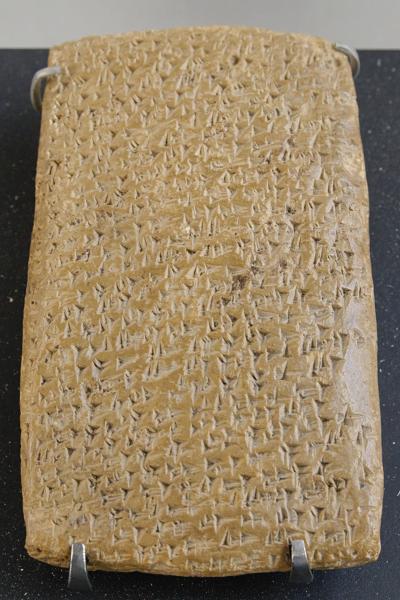
One of the Tell Amarna letters (Louvre Museum, Public domain CC 2.5)
Cuneiform writing on a clay tablet.
The Biblical map below shows the location of the site and the major cities during the ancient times. The city, marked with a red square, is located on the banks of the Besor brook, lying on a central crossroad.
Major ancient roads passed near the city:
-
The coastal road – The way of the Land of the Philistines, as per Exodus 1, 17: “And it came to pass, when Pharaoh had let the people go, that God led them not through the way of the land of the Philistines…”. Later it is called Via Maris – Way of the Sea. This was the major caravan route connecting the south west (Egypt) and the East (Mesopotamia) of the fertile crescent.
-
The road through Tel Gamma, to Judea and Hebron, along the Gerar brook. This road passed through other great cities – Tel Haror, Tel Ser’a (Tel esh-Sharia, Biblical Ziklag?)
South west of Israel – during the Biblical periods (based on Bible Mapper 3.0)
The Besor brook was a natural barrier, which enhanced the defense of the city. The Bible records that King David encountered a difficulty to cross it while pursuing the Amalekites invaders to the Negev (1 Samuel 30:10): “But David pursued, he and four hundred men: for two hundred abode behind, which were so faint that they could not go over the brook Besor.”.
-
Philistines (12th – 8th century BC)
During the 12th century the Philistines arrived to the cities along the shore. Tel Gamma became one of their cities. The area witnessed a surge in the settlement activity. The excavations unearthed an arched structure dated to this early period, with Philistine structures and ceramics. A large kiln for producing local ceramics was also found, dated to the 12th Century, although not clear if it was Philistine.
The autonomous Philistine rule continued in the 10th to the mid 8th Century BC. A four-room house dated to this period were found in the excavations. During the Iron Age the city covered an area of 40 Dunam (4 Hectares) with an estimated population of 800 inhabitants. In the 10th Century BC there were 15 rural settlements along the Besor basin near Tel Gamma, increasing the local commerce (“Arch. of Israel and the Levant”, p. 152, A. Shavit).
-
Assyrian and Babylonian conquest (8th – 6th C BC)
The Assyrian empire conquered the North Kingdom of Israel in 732BC, destroying most of the cities and villages in the land. The Assyrian King Tiglath-Pileser III annexed the area (as per 2 Kings 15: 29):
“In the days of Pekah king of Israel came Tiglathpileser king of Assyria, and took … and carried them captive to Assyria”).
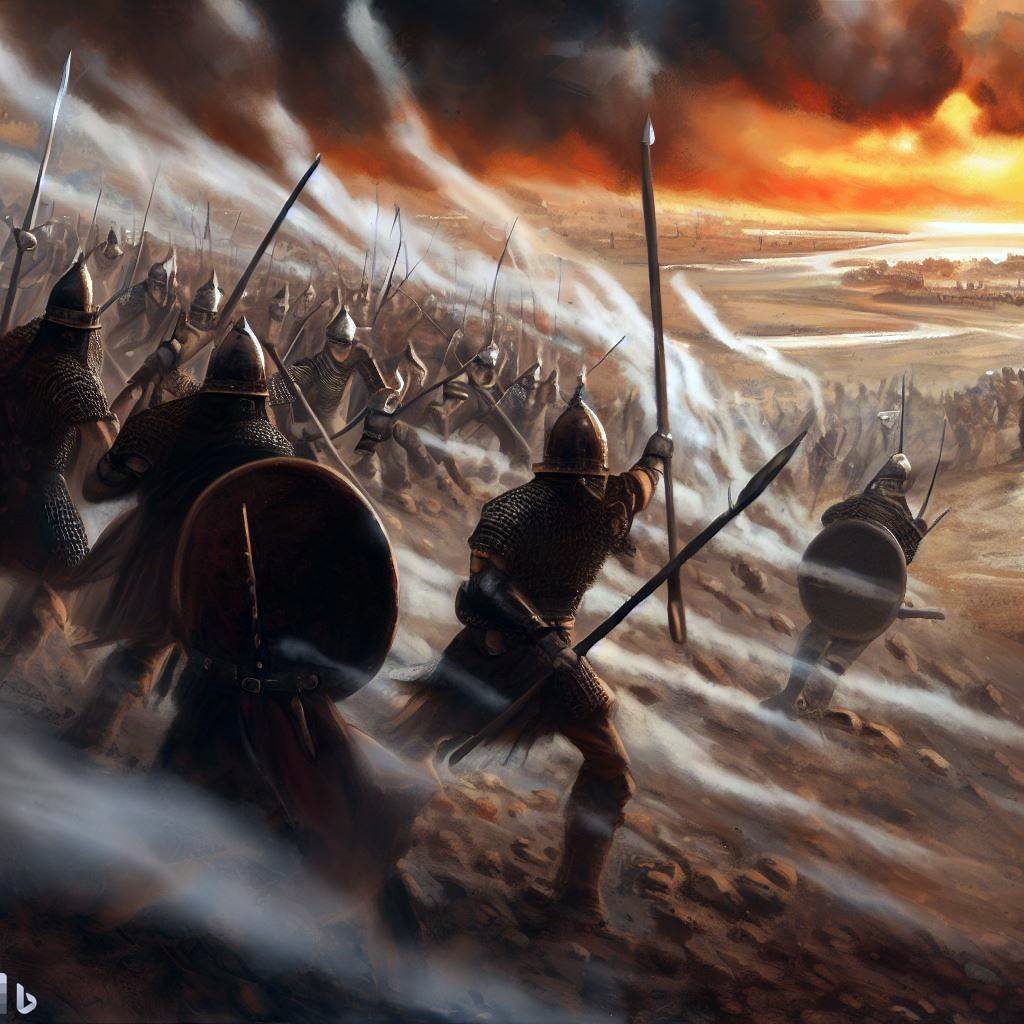
Assyrian forces attacking – AI generated by Bing
The Assyrians developed the Gaza coastal plain, making the Philistine cities – from Jaffa to Raphia – a kingdom subdued and raising taxes to the Assyrians. An Assyrian administration center was establish in Tel Gamma, and the city became an being an important trading post on the main caravan route between the sea and Arabia. The excavations indeed revealed a large structure, perhaps the governor’s palace.
The Babylonian empire rose after the fall of the Assyrians (610BC), defeated the Egyptians (609BC) and conquered the land until the Nile (2 Kings 24 7): “… for the king of Babylon had taken from the river of Egypt unto the river Euphrates all that pertained to the king of Egypt”. The Philistines presence ended after their cities were conquered by the Babylonians in 604 BC. The residents of the Philistine cities were relocated to Mesopotamia. This ended the 600 years of the Philistine presence in Israel.
-
Persian period (538-332 BC)
The Persian empire replaced the Babylonians in 538 BC. During the Persian period, most of the former cities of the Philistines were resettled by the Phoenicians.
From this period, the archaeologists unearthed a large structure, perhaps a fortress. This was the last major phase of occupation on the mound.
-
Hellenistic period (332 BC)
Alexander the great defeated the Persians and the Hellenistic period brought major changes to the cities of the Levant. Most of the ancient Tells ceased to function and new cities were established. On Tel Gamma the excavations found Silos made of mud bricks which are dated to the Hellenistic period.
-
Roman/Byzantine period
The site was abandoned, and a new settlement was established south of the deserted mound. Remains of this new site were found in salvage excavations east and south of Tel Gamma.
-
Ottoman period
A major battle was fought near Tel Gamma on October 28 1516, between the Turkish Ottomans, and the Egypt-based Mamelukes. This battle, known as the “battle of Khan Yaunis” (the nearby city in the Gaza strip), was an important milestone in the history of the land. The Mameluke cavalry (led by Janbirdi al-Ghazali) attempted to attack the Ottoman forces (led by Hadım Sinan Pasha) who camped here, in order to block their advance southwards. However, the Ottomans broke the cavalry charge. The Mamelukes, who ruled the Levant since 1215, were defeated and retreated to Egypt, while the Turks continued to advance through the Sinai.
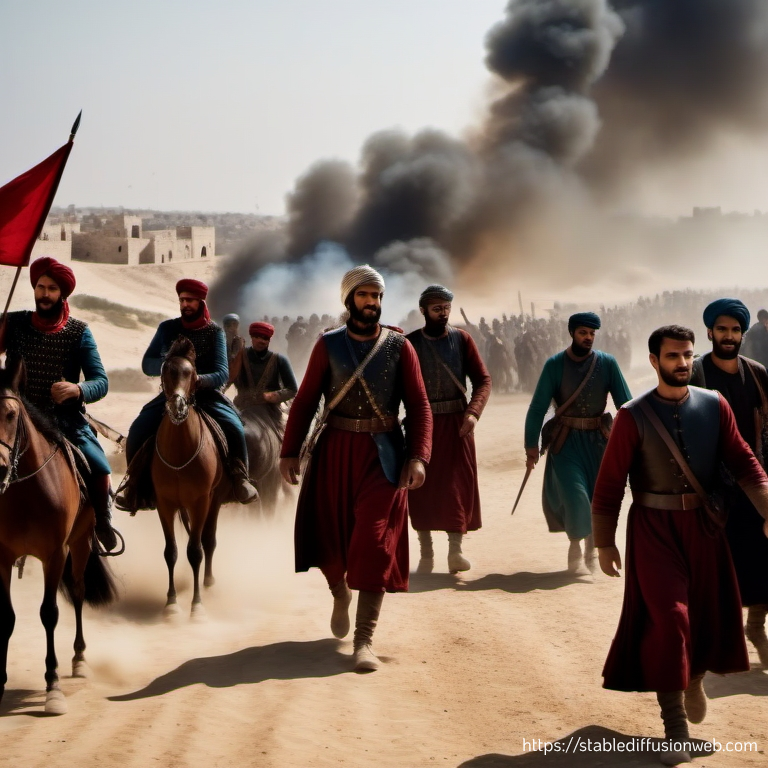
Ottomans win the battle at Tell el-Jamma (Stable Diffusion T2I)
After another battle of Ridaniya near Cairo, the Ottomans took control of the Levant, starting the Ottoman period which lasted 400 years.
PEF Survey:
Conder and Kitchener of the Palestine Exploration Fund (PEF) surveyed the area during the Survey of Western Palestine (SWP) in 1874-75.
The site, Tell Jemmeh (“plentiful well”), is shown in the center of the section of the PEF map here.
The PEF report about the site was short (Vol 3, Sheet XXIII, p 390):
“Tell Jemmeh – A large flat-topped bare mound, probably natural, on the side of the broad boundary valley. The scarps seem to have been artificially cut, and the mound is strewn with pottery”.
Part of map Sheet 23 of Survey of Western Palestine,
by Conder and Kitchener, 1872-1877.
(Published 1880, reprinted by LifeintheHolyLand.com)
-
World War I
On the foothills of Tel Gamma are signs commemorating the mounted infantry maneuver of the Australian and New Zealand Army Corps (Anzac) forces on Oct 31, 1917, during the World War 1.
Their bold mission was to surprise the Turkish forces in Beersheba in order to break the 8 months long deadlock of the British Army’s siege on Gaza. General Allenby, who was appointed just before this operation after the two failed attacks on Gaza, ordered a surprise charge as the first phase of his 5-steps plan to break the stalemate, capture Beersheba, and finally reach and conquer Damascus.
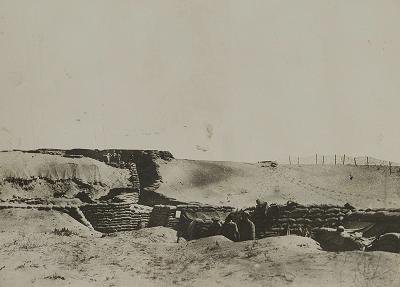
British forces dug in the sands of Gaza during WW1 – Library of Congress
The memorial accords of this bold campaign were documented in “The New Zealanders in Sinai and Palestine” (1922, p 60):
“General Allenby’s plan was to strike at Beershebathe enemy’s extreme leftand having taken the town with its invaluable water supply, to roll up the whole Turk line back upon Gaza. To do this the XX Corps was to attack Beersheba from the west and south-west, while the Desert Mounted Corps came in from the south, east and north”.
Before launching the cavalry, the British started with a heavy bombardment of Gaza, as a diversion. Then, over a long night and covering 45 Kilometers, the Anzac infantry reached their target, charged the enemy front during the day, and by nightfall entered into Beersheba.
Horses being watered at Tel-el-Jemmi after the second operation at Gaza.
Courtesy of Australian War Memorial
A memorial trail passes along the historic route of the Anzac forces. Its third station is located on the south side of Tell el-Jemmeh (Tel Gamma).
-
Modern Period – excavations
The site was first excavated by a team headed by W.J. Phythian-Adams of the PEF (1922), who cut a trench into the mound. This was followed by excavations of Sir Flinders Petrie (1926-1927), who excavated the western side of the summit.
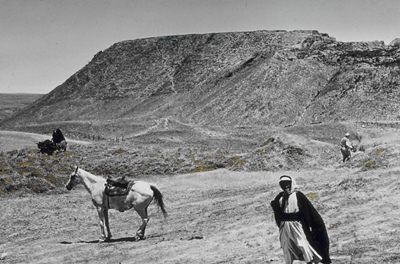
Tell Jemmeh (Gamma) – During the Petrie excavations in 1928
Photos of the Matson collection – Library of Congress
These archaeologists identified the place as the Biblical city of Gerar, based on the period of the layers and a nearby Byzantine site named Kh. Umm Jerrar (see map above). However, most scholars now agree that Tel Gamma was the city of Yurza, while Gerar is located elsewhere (Tel Haror?).
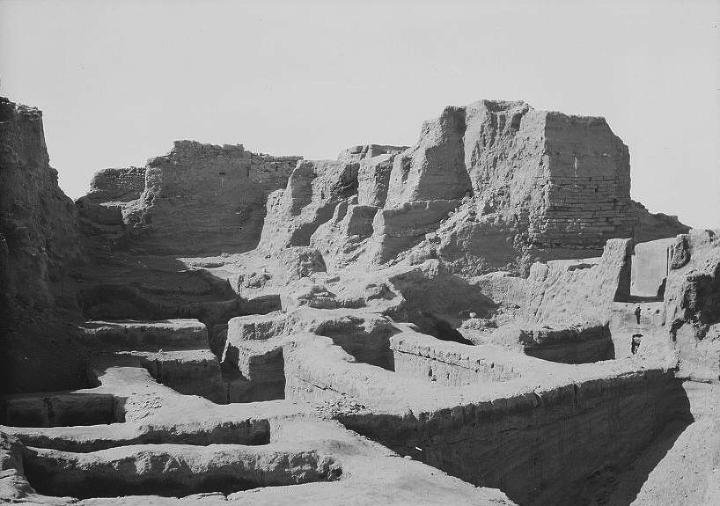
Tell Jemmeh “Solomonic level” – from excavations of the Petrie expedition ,
1927 [Matson collection; Library of Congress]
Later the site was excavated by Gus W. Van Beek in the years 1970-1990, on behalf of the Smithsonian Institute. A report was published in 1992.
-
The site today
The site is open to the public. You can climb up the steep mound, but be extremely careful not to get close to the edge of the summit.
Photos:
(a) Overview:
The following aerial view was captured by a quadcopter drone in December 2014. This view, from the south side, shows the artificially raised mound, hallowed in its center, situated along the bank of the Besor river, which is seen here behind it.
Click on the photos to view in higher resolution…
(b) Foothills:
This photo was captured in December, minutes after a heavy rain passed through the area. The hill is now covered with a low grass with blankets of wild flowers, but most of the year it is barren and brown. The average rainfall in the western Negev area is 250mm (9/8″).
An easy access up the mound is on the south side. The artificial mound, 50 Dunam (5 hectares) in area, is about 9m (30ft) above the area around it.
During our visit, a nice family from nearby Kibbutz Sa’ad came to visit the site. The friendly father, Itzik, told us about the area and their experience during the 2014 bombardments of the West Negev Kibbutz settlements along the Gaza strip. He also invited us to see the Amaryllis flowers that the Kibbutz grows in their greenhouse, intended mostly for exporting to Europe. Since the Christmas season shipments were already delivered, the family with seven children had time to travel to the sites of the West Negev.
The following photo is a view towards the south. You can park the car on this edge and climb up to the summit.
The mound is covered by thousands of Bronze and Iron age ceramic segments, as seen along the ascent path.
(c) Summit:
The northern side of the summit is shown here, with an eastern view of the basin of the Besor brook. Kibbutz Re’im is seen in the far background.
In this northwest section of the mound is a deep cavity, for some of the ancient structures caved in. Be careful not to approach the edges of the hill, as the northern precipice is dangerous!
(d) West side:
On the west side of the summit are remains of the Petrie excavation of the British school of Archaeology, which were conducted during six months on the years 1926-1927.
The Petrie excavation team cut deep into the layers on a large section of the west side. A photo of the dig is seen here on the right.
Excavations of the Petrie excavations, 1927
Matson collection, Library of Congress
Today the area of excavation left a large hole in the surface of the mound, as seen in the photo below.
(e) Nahal Besor stream:
The Besor stream basin is located on the north side of Tel Gamma, almost cutting into the hill.
The Besor loops around the mound, and is also seen on the western side of the hill. In the background are the houses of the Gaza strip, located 8km to the west.
Aerial video
![]() A flight over the site can be seen in the following Youtube video.
A flight over the site can be seen in the following Youtube video.
Etymology (behind the name):
* Names of the area:
- Tell Jemme, Jemmeh, Jamme – Arabic name of the mound. Means “plentiful well”.
- Tel Gamma – Hebrew name of the site, preserving the Arabic name.
- Wady Ghuzzeh (Wady Azzah)- Arabic name of Nahal Besor
- Besor – Name of the brook and region. It is referred in the Bible (1 Samuel 30:9-10, 21): “So David went, he and the six hundred men that were with him, and came to the brook Besor, where those that were left behind stayed. But David pursued, he and four hundred men: for two hundred abode behind, which were so faint that they could not go over the brook Besor…And David came to the two hundred men, which were so faint that they could not follow David, whom they had made also to abide at the brook Besor: and they went forth to meet David, and to meet the people that were with him: and when David came near to the people, he saluted them.”.
Links and References:
* External links:
- Tel Gamma East – Final report (2007) – salvage excavation east of the mound, with Byzantine remains
- Silver coins of the 4th Century BC from Tel Gamma – L.Y. Rahmani [IEJ 1971]
- Archaeological survey of Israel – Map 112 – Site 10 (IAA, Hebrew)
- Report on Soundings at Tell Jemmeh (W.J. Phythian-Adams, PEQ Volume 55 (3) 1 July 1923, pp 140-146)
- The Smithsonian Institute Excavation at Tell Jemmeh, Israel, 1970-1990 (David Ben-Shlomo, Gus W. Van Beek)
- Archaeology of Israel and the Levant (2008, Alon Shavit, p. 152)
- Battles of NZ unit in WW1 – Gaza campaign
- Conservation project Covering of Egyptian governor’s residence
* External Photos:
- Old photos of Tell Jemmeh – Library of Congress collection
- Australian War Memorial – photos of WW1
* Amarna letters:
- Tel el-Amarna letters – high resolution images
- Tell el-Amarna period – Carl Niebuhr (1903) – pdf, 62 pages
- Amarna letters in Reshafim web site
- Amarna letters in Research tool (good source of texts)
- Hi-Res images of the letters – Museum of Berlin (more than half of the tablets were acquired by the museum)
* Internal:
- Drone Aerial views – collection of Biblical sites from the air
- Youtube video – a drone flight over the site
- BibleWalks YouTube channel (join!)
- Story of a Tel (Mound)
BibleWalks.com – Exploring the ancient jewels of the Negev
Tel Be’er Sheba <—previous site—<<<All Sites>>>—Next Negev site—> Loz Cisterns
This page was last updated on Oct 14, 2023 (remove panorama)
Sponsored links:
